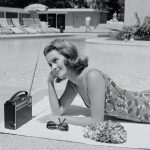The 60’s & 70’s

Internationalization
The acquisition of KPM by the EMI Group in the late 1960s marked the entry of major players in the music industry into production music. However, during these years, the activity remained a niche market reserved for independents. Outside of the EMI Group, no other major in the music industry showed serious interest. During this particularly prosperous period for popular music, many music illustration companies were established in countries where copyright was the norm.
In France, Sonimage/ Musique pour l’Image, a company created by Robert Viger, was already offering avant-garde production, revealing the creative potential of the industry by releasing albums of jazz and electro-acoustic music. Other companies, like Montparnasse 2000, or Télé Music, directed by Roger Tokarz, became market leaders. The catalog of Télé Music includes reference recordings that would later be sampled by famous Anglo-Saxon artists in the 1990s/2000s. Among its composers are Bernard Estardy, Pierre-Alain Dahan, Slim Pezin, and Marc Chantereau. Chappell France, for its part, published the now-cult recordings of Jack Arel and Jean-Claude Petit.
Eddie Warner’s company (not to be confused with Warner Brothers), L’Illustration Musicale, released *Western Patrol*, the oldest TV theme in France, for the show “Des Chiffres et des Lettres.” Its catalog also includes many works by Roger Roger and Nino Nardini, leading composers of the time. L’Illustration Musicale was acquired by Zomba Music in the 1990s, before being integrated into the BMG group in 2003, and then Universal in 2007.
In 1965, Gerhard Narholz founded Sonoton in Germany and Austria, the world’s largest independent production music company, which has remained a reference in German-speaking countries as well as in the USA. Another major German music library is “Selected Sound,” a member of the EMI Group, long managed by Hans Muller.
While there are many music libraries in the UK, France, and Germany, some of which only publish a few albums, Italy is not lagging behind in terms of innovation. Indeed, during the 60s/70s, a multitude of labels, original for some, or kitsch for others, emerge. Alongside the music illustration departments of major publishers such as CAM, state-owned Fonit-Cetra, Carosello, Leonardi, RCA Italiana, more than fifty independent labels are born. Among these, we note the labels created by composer Piero Umiliani, Liuto and Omicron, and Intermezzi, Alessandro Alessandroni’s label. Italian labels’ vinyl records are now particularly sought after by collectors for their characteristic sound, originality, and freedom of tone.
It should be noted that in Italy, the greatest film music composers such as Ennio Morricone, Riz Ortolani, Luis Bacalov, or Bruno Nicolai work for musical illustration under their own names; this is contrary to renowned musicians from other countries who prefer to sign their production music works under pseudonyms. The “BPM Score Music Series” collection (Universal) reflects this particularly creative period of Italian production music.
In 1968, Romano di Bari founds Canopo Edizioni Musicali before launching Flipper Music and its Primerose label in 1970. Flipper Music is still run today by his son Fabio di Bari. It is the most active independent label in the Italian market alongside Machiavelli.
In the UK, in 1977, the ATV Music Group founds Bruton Music, another major player in the sector, under the direction of Robin Phillips.
The Synthesizer - Another Instrument Making and a New Sound Palette
The appearance of the synthesizer marks a decisive step for production music. Gradually replacing electronic keyboards, such as Italian Farfisa, Bontempi, or Elka organs, most often used for economic reasons instead of strings, synthesizers, mainly the Moog, offer new timbres capable of illustrating the futuristic aspect of certain productions from the 70s and 80s.
A pioneer in its use, Jean-Jacques Perrey (1929 – 2016), in collaboration with Cecil Leuter, composes for numerous French music libraries, including l’Illustration Musicale and Creasound. Based in the United States since the early 60s, he collaborates with Gershon Kingsley, composer of Pop-Corn, the first international success of synthesizer music by the group Hot Butter in 1972. Originally composed for production music on the Bourne publishing label, Pop-Corn paves the way for numerous musical creations for image.
The Copyright Act
The American law of 1976, known as the Copyright Act, which establishes a separate property right on recordings (equivalent to our neighboring right), will revolutionize the relationships between media and recording producers. After the establishment of this law, the use of recordings in a television program requires prior authorization from their owners. The provisions of the Copyright Act give a new and decisive impulse to the development of production music in the United States. Production music publishers who, let us remember, hold the reproduction rights of both works and recordings, will not be slow to respond to the growing demand for music by the media.

